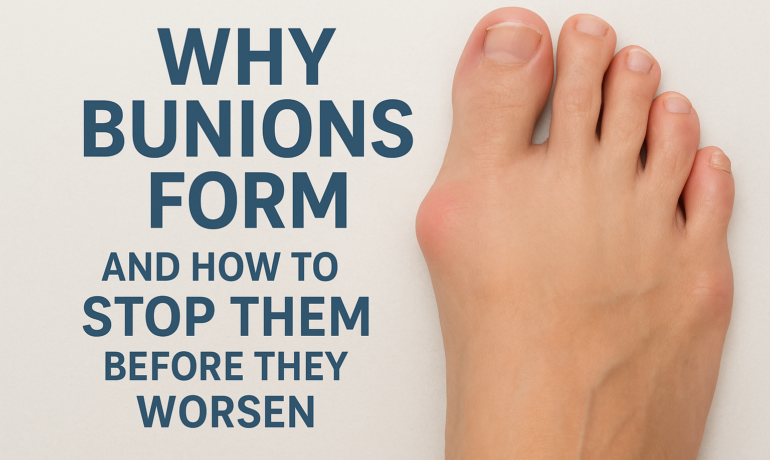Bunions, medically known as hallux valgus, are a common foot problem affecting millions worldwide. They appear as a bony bump at the base of the big toe, often causing discomfort, swelling, and difficulty walking. Understanding why bunions form is essential to prevent progression and avoid surgery.
What Causes Bunions?
Bunions develop due to a combination of genetics, foot structure, and lifestyle factors. Here are the main causes:
- Inherited Foot Shape – Flat feet or abnormal bone structure can increase bunion risk.
- Ill-Fitting Footwear – Tight, narrow, or high-heeled shoes push the toes together.
- Arthritis – Inflammatory conditions like osteoarthritis can weaken joint integrity.
- Foot Injuries – Sprains or fractures may trigger bunion formation.
- Muscle Imbalance – Uneven tension in foot muscles can pull the big toe out of alignment.
Early Signs to Watch For
Identifying bunions early can prevent worsening pain and deformity. Key symptoms include:
● Redness or swelling around the base of the big toe
● Persistent soreness while walking or standing
● Noticeable bump on the side of the foot
● Calluses or corns where toes rub together
● Limited range of motion in the big toe
How to Stop Bunions Before They Worsen
You can take several preventive and corrective measures to slow bunion progression:
Footwear Adjustments
● Choose shoes with a wide toe box
● Avoid high heels longer than 1-2 inches
● Use cushioned insoles to reduce pressure
Orthotics and Supports
● Custom orthotics help align the foot
● Toe spacers or bunion pads reduce friction
Exercises and Stretching
● Toe stretches to maintain flexibility
● Strengthening exercises for foot muscles
● Rolling a ball under the arch for relief
Lifestyle and Home Care
● Maintain a healthy weight to reduce foot strain
● Apply ice packs to alleviate swelling
● Massage the affected area to improve circulation
When to See a Doctor
If bunion pain becomes persistent or affects daily life, consulting a specialist is recommended. Surgical options exist but are generally reserved for severe cases. Early intervention with non-surgical treatments is most effective.
Conclusion
Bunions form due to a mix of genetics, footwear, and foot mechanics, but proper care can slow their progression. Early recognition and preventive measures like exercises, supportive footwear, and orthotics are key.
Taking proactive steps can save you from chronic pain and reduce the likelihood of surgery. Don’t ignore persistent foot discomfort—it can impact mobility and overall quality of life.
For personalized care and treatment, consult our Dr. Aditya Somayaji, Ortho Specialist.

